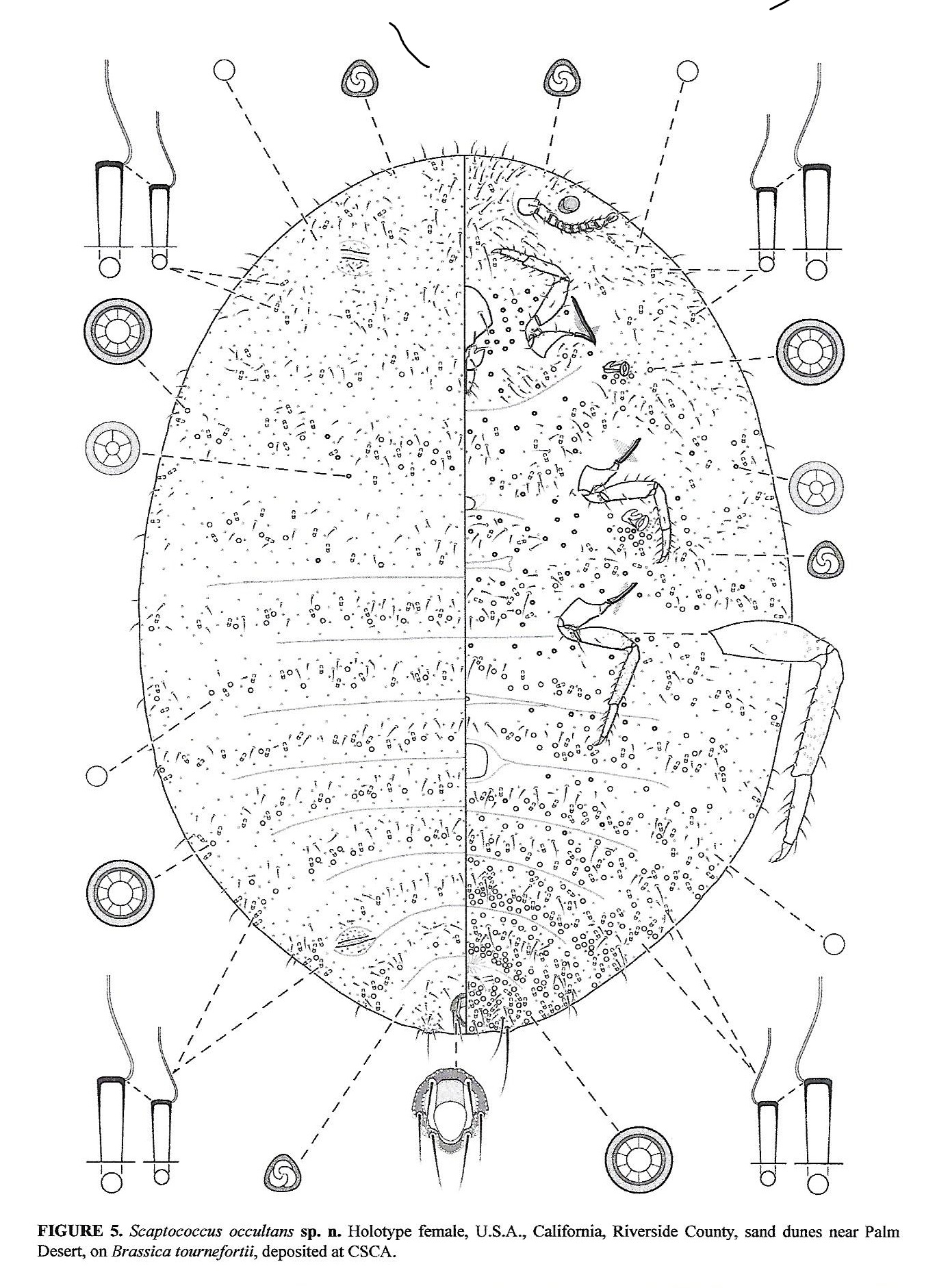Valid Names Results
Scaptococcus occultans von Ellenrieder & Watson, 2019 (Pseudococcidae: Scaptococcus)Nomenclatural History
- Scaptococcus occultans von Ellenrieder & Watson 2019: 392. Type data: U.S.A.: California, Riverside County, sand dunes near Palm Desert, 38th Avenue and Washington Street (33º 46'23'' N, 116º 18'14'' W, 34 m. a.s.l.), on Brassica tournefortii, 3/31/2011, by R.Waterworth. Holotype, female, by original designation Type depository: Sacramento: California State Collection of Arthropods, California Dept. Food & Agriculture, California, USA; accepted valid name Notes: Paratypes: 177 ♀♀ (154 adults, 23 immatures), 5 adult ♂♂ Illustr.
Common Names
Ecological Associates
Hosts:
Families: 6 | Genera: 8
- Amaranthaceae
- Atriplex | VonEllWa2019
- Bassia | VonEllWa2019
- Salsola | VonEllWa2019
- Asteraceae
- Asteraceae | VonEllWa2019
- Brassicaceae
- Brassica tournefortii | VonEllWa2019
- Fabaceae
- Dalea | VonEllWa2019 | (= Parosela)
- Hypericaceae
- Hypericum perforatum | VonEllWa2019
- Zygophyllaceae
- Tribulus terrestris | VonEllWa2019
Geographic Distribution
Countries: 1
- United States
- California | VonEllWa2019
Keys
- VonEllWa2019: pp.399 ( Adult (F) ) [Species of Scaptococcus]
Remarks
- Systematics: The adult female of Scaptococcus occultans shares with S. californicus and S. milleri the presence of a denticle on each claw, modified oral collar tubular ducts with the inner half of the outer duct sclerotized, multilocular pores, quinquelocular pores, and the absence of cerarii. It is superficially most similar to that of S. milleri, in that both have at least one circulus, dorsal modified oral collar tubular ducts, dorsal multilocular pores and dorsal quinquelocular pores, and cellular pores on the anal ring. Adult females of S. occultans can be distinguished from those of both S. californicus and S. milleri by their unmodified legs, with the prothoracic tibia + tarsus longer than the femur (legs short and stout in S. californicus and S. milleri, with prothoracic tibia + tarsus shorter than femur), and less prominent claw denticles, and additionally from S. milleri by the presence of numerous dorsal modified oral collar tubular ducts, quinquelocular pores and multilocular pores arranged in bands across the thoracic and abdominal segments (in S. milleri there are only a few dorsal modified oral collar tubular ducts, quinquelocular and multilocular pores, mostly on the posterior abdominal segments). Female nymphs of all three instars of S. occultans can be distinguished from those of the other two Scaptococcus species by their unmodified prothoracic legs, with the tibia + tarsus longer than the femur (tibia + tarsus stout and shorter than femur in S. californicus and S. milleri), smaller claw denticles, and the unmodified anal ring, with cellular pores present in two rows (in S. californicus and S. milleri, the cellular pores are absent or in a single row). (von Ellenrieder & Watson, 2019) The prothoracic femur is stouter in the adult males of Scaptococcus milleri than in S. occultans. They also share with their females the presence of a denticle on each claw. The prothoracic denticle has a wide base and right-angled tip in the adult male of S. milleri, whereas it is spine-like, smaller and slender, with an unusually narrow base and acute tip in the adult male of S. occultans. (von Ellenrieder & Watson, 2019)
- Structure: Adult female body oval and rotund, brownish orange to maroon-brown, enclosed in a cover of felted white wax. (von Ellenrieder & Watson, 2019) Slide-mounted characters adult female oval, becoming larger and more rotund with age, 2.2± 0.7 [2.2] (1.1–3.0) mm long, maximum width (at metathorax) 1.6 ± 0.7 [0.6] (0.7–2.6) mm. Anal lobes slightly developed (in younger females) to absent (in older females), each with an apical seta 155 ± 10 [161] (129–166) μm long. Antenna 268 ± 13.2 [255] (239–286) μm long, with 9 segments. Legs well developed. (von Ellenrieder & Watson, 2019) In first-instar nymphs the antenna is 6-segmented, and 7-segmented in second- and third-instar female nymphs. All three nymphal instars share with the adult female the presence of anterior and posterior ostioles, a small plantar denticle on the claw, trilocular pores, quinquelocular pores, a circulus and an anal ring with two rows of cellular pores. Modified oral collar tubular ducts were not detected in first-instar nymphs but are present in second- and third-instar female nymphs. Besides lacking a vulva, all nymphs differ from the adult female by lacking multilocular pores. (von Ellenrieder & Watson, 2019) Body of adult male elongate oval, 1,286 ± 163 (1,010–1,440) μm long, maximum width of mesothorax 357 ± 28 (325–390) μm; fleshy setae entirely absent; all setae hair-like (flagellate with acute apices longer setae proportionally slightly thicker than shorter ones); discoidal pores and multilocular pores present, the latter mostly each with 5 loculi, but a few with 4. Antenna length between half and almost two-thirds of body length. Male macropterous, with wings each 1.2 ± 0.1 (1.04–1.23) times as long as total body length and 0.32 ± 0.5 (0.28–0.35) as wide as long. (von Ellenrieder & Watson, 2019)
- Biology: Scaptococcus occultans occurs on the crown and roots of its hosts. The adult female secretes a cover of felted white wax, which encloses both her body and the eggs. (von Ellenrieder & Watson, 2019)
- General Remarks: Detailed description, illustration and photographs of the living adult female in von Ellenrieder & Watson, 2019.
Illustrations
Citations
- VonEll2025: distribution, host, 34
- VonEllWa2019: biology, description, diagnosis, dispersal, distribution, host, illustration, key, male, taxonomy,




